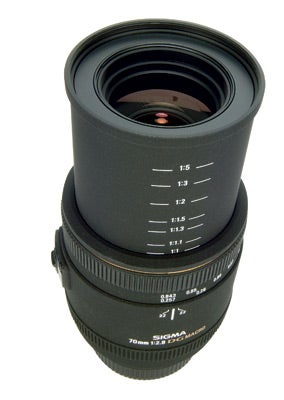With an f2.8 aperture and macro, this looks special...
Sigma 70-200mm f/2.8 EX DG Macro HSM Review
The last version of these lens was a cracker, and now Sigma has revamped it and added a macro function too, making it a very attractive proposition indeed.
First of all lets break down the name. Notice first of all the f/2.8 aperture. That’s the maximum throughout the whole of the focal length, from 70mm up to 200mm. That’s a lot of light gathering power, so understandably the lens is bigger than your average f/3.5-5.6 type zoom. In fact, it’s constructed from 18 elements arranged in 15 groups, and the overall weight of those optics amounts to 1345g, so it’s no lightweight. Externally it’s also well made, with a metal mount, a tough shell and deep and secure rubberised zoom and focus rings. There’s also a detachable tripod mount-ring to alleviate strain on the camera mount if using a tripod.
Among that glass are apochramtic elements, extra low dispersion and special low dispersion elements. All of these combine to correct distortion and colour and reduce chromatic aberrations. The EX moniker marks this as being in Sigma’s premier line up, hence the build quality and price, though it’s somewhat cheaper than similar lenses from Nikon or Canon et al. As a DG lens, Sigma is also telling us this is digitally optimised, not just for APS-C sensors but also full-frame cameras, so it could be easily used for those Canon 1Ds MkII’s that I know all of our readers own! Of course, it would also work on 35mm film cameras, if you still use them.
The lens also has a Hyper Sonic Motor fitted (HSM), which is fast and quiet, making the lens useful for high-speed photography, sports, wildlife and more. Focusing is internal too, so the physical dimensions of the lens don’t change, while the AF servo also allows manual focus in AF mode for quick corrections – especially useful in macro mode or when at maximum aperture.
Finally it’s had that macro function fitted, allowing focusing as close as 100cm throughout the entire zoom range.
Image Quality
The test charts show really good performance at 70mm, with performance peaking at f/5.6 which is not surprising and staying high throughout. At 200mm the lens is still tasty, and performs best at f/11, before the sharpness dips quite sharply at f/16 and 22.
The lens also has good control of chromatic aberrations, with excellent perfomance in the centre throughout the focal range, and only minor fringing occurring at the edge and corner of the frames. It’s worth bearing in mind that we tested this lens with a Canon EOS 350D; aberrations will worsen on a full-frame camera, but the curve appears even and I doubt that it will be a problem.
Real world images look great, with sharp edges and good colour, although they’re a little flat based on the Canon results. The macro results are good too, though if anyone can explain why a gale always blows up when I go to take pictures of plants, I’d be most grateful!
Verdict
It's expensive, but not as expensive as similar lenses from the first-party manufacturers. If you want speed, quality and versatility, the chunky Sigma 70-200mm lens is a belter.





